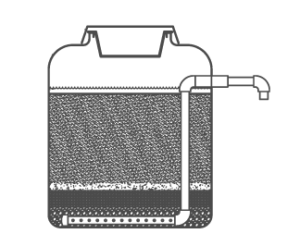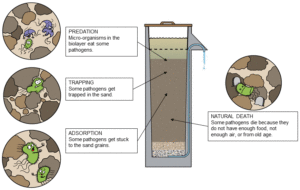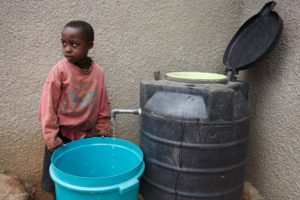Let’s talk about our final solution under the category of biological intervention. Generally, biological interventions use bacterial processes to remove harmful bacteria from water. Some of the solutions included under this heading [including antimicrobial metals and activated carbon] don’t cleanly fit this description, but they are often used alongside biological interventions – like today’s topic: Bio-Sand Filters.
Before we get started, here is your standard reminder: You’re joining 20 Liters in an ongoing conversation. So, feel free to go back and catch up with us. We’ve already covered each part of the WASH acronym [Water, Sanitation, Hygiene], made sure we have a shared language, and looked into disparities for vulnerable populations.
Now, we’re working our way through a discussion about various solutions to make dirty water clean. We’ve divided the solutions into a few categories:
Physical Intervention: including filtration, adsorption, sedimentation, boiling & distillation
Biological Intervention: including antimicrobial metals, activated carbon & bio-sand filters
Chemical Alteration: including chlorination & flocculation
Electromagnetic Radiation: including UV Light treatment
Sourcing: including rainfall, groundwater, underground aquifers, springs, and human-intervened (bottled, wells or municipal water).
Bio-Sand Filters [aka Slow-Sand Filtration]
 First, we need to shout-out to Bob Johnson, who was one of the founding members of the Water Team that became 20 Liters. He was also a pioneer in adapting large-scale bio-sand filter systems for household use. He is the reason we know and love this particular solution.
First, we need to shout-out to Bob Johnson, who was one of the founding members of the Water Team that became 20 Liters. He was also a pioneer in adapting large-scale bio-sand filter systems for household use. He is the reason we know and love this particular solution.
Bio-sand filters are made up of layers of sand and gravel. Starting from the bottom of the filter, first, there is a layer of drainage gravel. Next, there is a layer of intermediate separation gravel. Then, there is a deep layer of fine sand on the top. Finally, as dirty water is fed into the filter over the course of the first two weeks, a community of micro-organisms form on the surface of the fine sand, creating a fourth biological layer to the filter.
This ingenious filter utilizes 4 distinct mechanisms to remove pathogens.

The first mechanism is Predation. The pathogens have to first survive each other. The larger bacteria and protozoa feed on the smaller ones. The larger bacteria have a harder time squeezing through the sand, so we’re more than happy to have them eat up the smaller stuff.
The next mechanism is Trapping. Water passes through sand because sand particles are irregularly shaped and don’t press tightly against each other. By sifting our sand to the right size, we can ensure channels are too small for the majority of the bacteria to pass through, but still wide enough for water molecules.
Adsorption is the next mechanism. Silica and other sand materials have naturally sticky surfaces at the atomic level, because of surface energies and electromagnetic attractions. Pathogens can actually get stuck to the surface of the sand particle.
The final mechanism is Natural Death. Pathogens that do manage to make it deep into the sand layer run out of food, light and air and die off.
Now, a little history lesson:
The slow sand or bio-sand filter has been around since the 1800’s. It was first developed in England. The city of London used bio-sand filters to fight cholera and typhoid fever epidemics. Still today, some municipalities implement this technology, using large-scale bio-sand filters, usually as a first filtration step before chemical treatment.
Far more recently, bio-sand filters were adapted for household use. Dr. David Manz of the University of Calgary was the first to develop this technology in the late 1980’s. His research showed that a bio-sand filter could be downsized. In his research, he concluded that, if housed in a concrete tank, the filter could still be effective on a small scale and run intermittently.
Later, Dr. Robert MacDonald, the founder of AquaClara, successfully showed that the layers could be placed in just about any type of container and the filter would still work. This was revolutionary when you consider the logistical challenge of molding concrete tanks in rural areas of developing countries. By proving that bio-sand filters could be effective in a container like a 150-liter plastic tank [which is what the 20 Liters Slow-Sand Filter utilizes], Dr. MacDonald made it logistically possible to get these filters to households that desperately needed them.
Dr. MacDonald’s research also showed that the most important factor in the effectiveness of the filter was the amount of water run through the system each day. Ideally, the user will feed twice the amount of water as can be retained in the sand through the system each day. This ensures that the water fed into the system moves very slowly [hence, the alternate name of “slow-sand” filter]. This finding led to a re-design of bio-sand filters so that the tank would hold more sand and less water [to ensure that water would move through slowly, increasing the effectiveness of the filter].
The Benefits of Bio-Sand Filters:
Sand is available almost anywhere in the world. And, it can be prepared for the filter with only simple tools. Many designs for bio-sand filters take advantage of additional solutions, like anti-microbial metals, to further increase effectiveness. And, the filter doesn’t have any moving parts to break or wear out. So, this filter can literally last forever.
My favorite benefit of using a bio-sand filter is also the most unexpected benefit. These filters operate the best when the water you’re using is the absolute worst. If you are consistently using surface water that is alive with bacteria, parasites, and all matter of gross stuff – this is the filter that you want. Because the worse the stuff going in is, the more hard-core your top biological layer is going to become, and the better your filter is going to work.
But every positive has a negative:
Not only does this filter works best with really gross, really dirty water; using clean water through the system, even just occasionally, can be dangerous. The higher quality water can starve the biological layer and allow bacteria to grow in the deeper layers of the sand. Without testing, you don’t know if you’ve killed your biological layer.
The quality of the water isn’t the only way to negatively impact your filter. If you feed too much water into the system too quickly, the natural processes won’t have time to be fully effective. And if you add too little water, your biological layer could starve.
While training can alleviate these concerns, as with almost all solutions, without testing, there’s no way of knowing if all microbes have been removed and smaller viruses will still pass through the system.
Finally, a typical bio-sand filter weighs around 200lbs. So, if you plan to live in one place for a long-time, it can be a worthwhile investment. But if you move, it probably isn’t going with you.
A final note on bias.
 20 Liters may be a little biased about Slow Sand Filters, because they are one of the solutions that we implement in Rwanda to make dirty water clean. Specifically, we use them in areas near to the Nyabarongo River. In these areas, residents consistently use swamp or river water that is heavy with sediment and filled with nasty bacteria. You can find more details about our implementation on our interactive program map.
20 Liters may be a little biased about Slow Sand Filters, because they are one of the solutions that we implement in Rwanda to make dirty water clean. Specifically, we use them in areas near to the Nyabarongo River. In these areas, residents consistently use swamp or river water that is heavy with sediment and filled with nasty bacteria. You can find more details about our implementation on our interactive program map.
Reading list (for nerds):
https://www.cawst.org/services/expertise/biosand-filter/more-information
https://www.biosandfilters.info/
